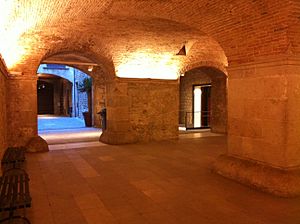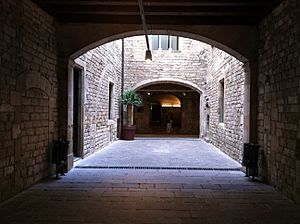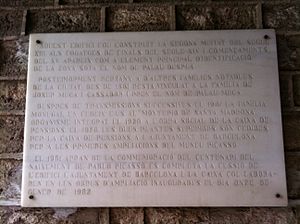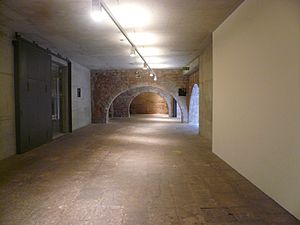Museu Picasso facts for kids
| Museo Picasso de Barcelona | |
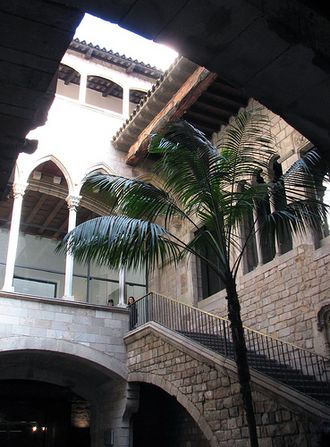 |
|
| Lua error in Module:Location_map at line 420: attempt to index field 'wikibase' (a nil value). | |
| Established | 9 March 1963 |
|---|---|
| Location | Montcada Street, Barcelona, Spain |
| Type | art museum |
| Visitors | 1,047,094 (2023) |
The Museu Picasso (which means "Picasso Museum") is a famous art museum in Barcelona, Spain. It holds a huge collection of art by the Spanish artist Pablo Picasso. The museum has 4,251 of his artworks.
It is located in five old palaces on Montcada Street in Barcelona's Old City. The museum first opened on March 9, 1963. It was the first museum ever made just for Picasso's art. It was also the only one opened while he was still alive. The Government of Catalonia has called it a museum of national interest.
Some of the most important artworks here are two of his first big pieces: The First Communion (1896) and Science and Charity (1897). The museum helps us understand Picasso's special connection with Barcelona. This connection started when he was young and lasted his whole life.
Contents
History of the Museum
The idea for the museum came from Jaume Sabartés. He was Picasso's friend and secretary for many years. Picasso had given Sabartés many paintings, drawings, and prints. Sabartés first wanted to open the museum in Málaga, where Picasso was born. But Picasso thought Barcelona was a better choice. He had strong ties to the city.
On July 27, 1960, Sabartés agreed with Barcelona to create the museum. It opened in 1963. The first collection came from Sabartés, who gave 574 artworks. Picasso also gave some works to the city, like Harlequin. Other pieces came from Barcelona's modern art museum and gifts from Picasso's friends.
The museum was first called the Sabartés Collection. This was because Picasso did not like Franco's government. The mayor of Barcelona, Josep Porcioles, opened the museum even though the government did not want him to. When it opened, the museum was in Palau Aguilar on Montcada Street. At first, the collection mostly had Sabartés' art, some lithographs, and posters.
Other gifts came in the first year. Salvador Dalí gave a book of engravings Picasso made for Ovid's Metamorphoses. Gala Dalí gave a collage called No, from 1913. Later, the collection grew with more donations. For example, Junyer Sebastian Vidal gave seven drawings from 1899 to 1904.
How the Museum Grew
After Sabartés passed away in 1968, Picasso made his last personal gift to the museum in 1970. This gift included 920 different artworks. Many were from his early years that his family had kept for him. These included school books, art from his training, and paintings from Picasso's Blue Period. Sabartés also left many works to the museum when he died. This included a series of 58 paintings based on Las Meninas.
In December 1970, the museum got bigger for the first time. It added the Palau del Baró de Castellet, which is next to the first building, Palau Aguilar. As years went by, the museum became more important. More big donations were made. In the early 1980s, the collection grew with gifts from people and art galleries. The museum also bought new artworks.
In 1982, Picasso's wife, Jacqueline Roque, gave 41 artworks to the museum. In 1983, the Louise Leiris Gallery gave 117 engravings. Important gifts also came from Carles Domingo and Editorial Gustavo Gili. In 1985, the museum expanded again. It added Palau Meca.
In the 1990s, donations included a woman's bust and Man sitting. The museum also bought works like Portrait of Jacqueline with tape. In the late 1990s, the museum grew even more. It added Casa Mauri and Palau Finestres, which are on the same street. This new part opened in 1999. It added 3,400 square meters for temporary art shows, an auditorium, and other services. The first show in this new space was Picasso: Interior and Exterior Landscape. It had over 200 of his works from 1917 to 1970.
The Museum in the 21st Century
In 2003, the inside of the museum was updated. The artworks were arranged in new ways. Two years later, in 2005, the Government of Catalonia said the museum was of national interest.
In 2006, Maite Ocaña, who had been the museum's director since 1983, left to lead the National Art Museum of Catalonia. Pepe Serra became the new director of the Picasso Museum that same year. In 2008, the Museu Picasso changed its permanent collection layout. It opened new rooms for engravings, including one for Sabartés.
Pepe Serra also started a group of organizations connected to Picasso. These include the City of Gósol and the Centre Picasso of Horta de Sant Joan. The goal is to promote Picasso's art in Catalonia. In 2009, The Art Newspaper listed the museum as one of the 40 most visited art museums in the world.
In 2010, the museum started using social networks like Twitter, Flickr, and Facebook more. Their efforts won them an award for social media in 2010. The museum uses social media to encourage discussions about its research and knowledge.
More recently, the museum built a new building in Sabartés Square. This building is behind Montcada Street. It helps with the crowds at the museum's entrance. The architect, Jordi Garcés, also designed the museum's previous expansion.
Museum Buildings
The Museu Picasso is in five large houses or palaces on Carrer de Montcada in Barcelona. These buildings are from the 13th and 14th centuries. They cover a total area of 10,628 square meters. The buildings are in the Gothic civil Catalan style. Each of the five buildings has a similar design. They are built around a courtyard with an outside staircase. This staircase leads to the main floors. These buildings that hold Picasso's art also have their own long history.
Palau Aguilar
The Palau Aguilar (Montcada, 15) was the first building the museum used. It was likely built on the home of James Ses sources, an important person in Barcelona. The building is from the 13th century. But it was changed a lot between the 15th and 18th centuries. From the 13th to 14th centuries, it belonged to noble families. In 1386, the Corominas-Desplà family bought it. They sold it 14 years later to Berenguer Aguilar, which is where the palace got its name. Later, other wealthy families owned it. The city council bought it on November 3, 1953.
During a restoration in 1960, a 13th-century painting was found. It was hidden under plaster in one of the rooms. Today, this painting is shown at the National Art Museum of Catalonia. It is a large painting showing the conquest of Majorca in 1229. The painting has symbols like cauldrons and roses. This suggests the palace belonged to the Caldes and Desvalls families. It shows the central courtyard of the building in the 15th century. It has an open staircase and a pointed Gothic arch.
Palau Baró de Castellet
The Palau Baró de Castellet (Montcada, 17) is another medieval palace. It was built in the 13th century. The Gerona family owned it in the 15th century. Since then, it has been owned by different wealthy families in Barcelona. It was remodeled in the 18th century. In 1797, the owner, Mariano Alegre Aparici Amat, was given the title of Baron Castle by King Charles IV. This is how the palace got its name.
When the Baron died, he left the building to the Hospital of the Holy Cross. The hospital rented it out until they sold it to the Rivers family. The city council then bought the building in the 1950s. This palace is also built around a central courtyard. Its front has a 16th-century relief showing religious scenes. The main floor inside is in the neo-classical style from the mid-18th century. It has marble and colorful reliefs.
Palau Meca
The Palau Meca (Montcada, 19) was built between the 13th and 14th centuries. It was also restored in the 18th century. Like the other palaces, it has a central courtyard. Special features include the colorful medieval ceilings on the main floor. It also has unique ceilings from the 19th century. In 1349, James Knight, a city council minister, owned the property. His grandson, Ramon Desplà Knight, made it the biggest palace on the block.
The building later belonged to the Cassador (or Hunter) family. The first owner, Joseph Mecca Hunter, gave the palace its current name. The next family, the Milans, fixed the building after it was badly damaged during the War of Spanish Succession. In 1901, the building was given to the Brothers of Christian Doctrine. It later became part of a bank. The bank gave the building to the city council on December 5, 1977. The palace reopened as part of the museum on January 11, 1982.
Casa Mauri
Casa Mauri (Montcada, 21) has parts that date back to Roman times. Back then, this area was outside the city of Barcino. A special feature is its wooden front, which is rare in Barcelona. It shows an 18th-century locking system. Between 1378 and 1516, the Rocha family owned the building. In 1716, F. Casamada owned it. Several changes were made in the 19th century.
Under Josep Vidal Torrents, the building was used for industrial purposes. Then, Mauri bakeries bought it in 1943, giving the building its name. In 1999, the Museu Picasso bought the building.
Palau Finestres
The Palau Finestres (Montcada, 23) was built on top of a 13th-century building. It is also on an old Roman burial ground. From 1363 to 1516, the Marimon family owned this area. In 1872, Jose Vidal Torres, who owned Casa Mauri, bought this building to add it to his home. The city bought the building in 1970.
There are arches on the ground floor. These were added during changes in the 15th and 17th centuries. On the main floor, a wooden ceiling from the late 13th century has been restored. This building is now used for art exhibitions.
Knowledge and Research Center
The Knowledge and Research Center opened on February 17. It is a new building in Plaza Sabartés. Architect Jordi Garcés designed it. This center aims to be an important place for studying Picasso and his art. Director Pepe Serra said the space would be for discussions and debates.
Jordi Garcés, who also designed the museum's earlier expansion, created the 1,500-square-meter building. It has a clear glass front protected by a part that sticks out. The ground floor has an educational center with four rooms for learning activities. The first floor holds the library, documentation center, and museum archives. The basement is for visitor services. Construction started on July 10, 2009, and finished on February 16, 2011. It cost 6.7 million euros.
The Art Collection
The museum's permanent collection is divided into three parts: paintings and drawings, engravings, and ceramics. Most of these artworks are from Picasso's early life, like his Blue Period (1901–1904). But Picasso, his family, and friends also gave or loaned later pieces. Now, there are more than 3,500 artworks in the permanent collection.
The collection is arranged into sections. These include his early years (Málaga, Corunna, and Barcelona, 1890–97). There's also his training period (Barcelona, Horta de San Juan, and Madrid, 1897–1901). Other sections cover the Blue Period (1901–04) and works from Barcelona in 1917. The entire Las Meninas series (1957) is also here.
Most of the paintings on display are from 1890 to 1917. This is a very important collection for that part of Picasso's life. The museum has very few paintings made after 1917. The Las Meninas series, painted in 1957, is an exception. The collection of lithographs covers the years 1962 to 1982. Picasso himself gave the museum a copy of each work he made after Sabartés died in 1968. The collection also has drawings he made for books. Picasso's wife, Jacqueline, gave the museum ceramics.
Between 2009 and 2010, the museum started putting information about its collection online. By October 2010, over 65% of the museum's collection could be seen on its website.
Special Exhibitions
The Picasso Museum has held many exhibitions since it opened. These shows often focus on Picasso or things related to his life. They try to explore and understand his work. Sometimes, they show how Picasso related to other artists, like the "Picasso vs. Rusiñol" exhibition in 2010.
The museum also organizes traveling exhibitions. For example, "Bullfighting: Paintings, drawings and prints" from the museum's collection was shown in Salamanca in 2010. They also have smaller shows called "displays." These focus on one topic, like analyzing the painting Science and Charity. They show results from X-ray studies of the painting. The museum often hosts special exhibitions with art by Picasso and other artists. From time to time, the museum also holds seminars and talks. These are about Picasso or museum topics. Experts from all over the world give these talks.
Directors
- Joan Ainaud Lasarte (1963–1966)
- Rosa Maria Subirana (1966–1983)
- Maria Teresa Ocaña (1983–2007)
- Pepe Serra (2007–2011)
- Bernardo Laniano Romero (2012–2016)
- Emmanuel Guigon (2016-)
See also
 In Spanish: Museo Picasso de Barcelona para niños
In Spanish: Museo Picasso de Barcelona para niños
- Musée Picasso (Paris)
- Museo Picasso Málaga
- List of single-artist museums
Images for kids


